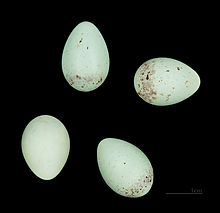| Arctic redpoll | |
|---|---|
_(13667519855).jpg) | |
LC (Partners in Flight)[1] | |
| Scientific classification | |
| Kingdom: | Animalia |
| Phylum: | Chordata |
| Class: | Aves |
| Order: | Passeriformes |
| Family: | Fringillidae |
| Subfamily: | Carduelinae |
| Genus: | Acanthis |
| Species: | A. hornemanni |
| Binomial name | |
| Acanthis hornemanni (Holbøll, 1843) | |
| Synonyms | |
| Carduelis hornemanni | |
The Arctic redpoll or hoary redpoll (Acanthis hornemanni) is a bird species in the finch family Fringillidae. It breeds in tundra birch forest. It has two subspecies, A. h. hornemanni (Greenland or Hornemann's Arctic redpoll) of Greenland and neighbouring parts of Canada, and A. h. exilipes (Coues' Arctic redpoll), which breeds in the tundra of northern North America and the Palearctic. Many birds remain in the far north; some birds migrate short distances south in winter, sometimes travelling with common redpolls.
The genus name Acanthis is from the Ancient Greek akanthis, a name for a small now-unidentifiable bird, and hornemanni commemorates the Danish botanist Jens Wilken Hornemann.[2] The name "arctic redpoll" is used in Europe and "hoary redpoll" in North America.
Description
The Arctic redpoll is similar in appearance to the common redpoll but generally paler. It may be distinguished from that species by the unstreaked pale rump patch and the uniformly pale vent area. The Greenland race is a very large, pale bird, with the male sometimes described as a "snowball", but both forms are pale with small beaks, white rumps and often more yellow than grey-brown tones in their plumage. They have black bibs, orangish forehead patches and two light-coloured stripes on each wing. The females are more streaked on their breasts, sides and rumps, but are still pale. Adults are about 12 to 14 centimetres (4.7 to 5.5 in) in length and weigh about 12 to 16 grams (0.42 to 0.56 oz).[3] Wingspan ranges from 20 to 25 cm.[4]
Phylogeny
The phylogeny has been obtained by Antonio Arnaiz-Villena et al.[5][6]
Behaviour
The Arctic redpoll is partially migratory and tends to move southwards in November and north again in March and April. It feeds mainly on seeds, particularly of alder and birch trees.[3]
Breeding takes place from May to July. The nest is built low down in a tree or bush and is neatly built with an outer layer of twigs, a middle layer of root fibres, fragments of juniper bark and lichens and an inner layer of down, willow buds and reindeer hair. Three to seven pale blue eggs with light reddish speckling are laid and incubated by the female. They hatch after about eleven days and the young fledge in about a further thirteen days.[3]
References
- ^ "Hoary Redpoll: Life History". Cornell Lab of Ornithology. Retrieved 2 November 2020.
- ^ Jobling, James A. (2010). The Helm Dictionary of Scientific Bird Names. London, United Kingdom: Christopher Helm. pp. 29, 195. ISBN 978-1-4081-2501-4.
- ^ a b c "Arctic Redpoll: Carduelis hornemanni". NatureGate. Retrieved 2013-12-13.
- ^ Oiseaux.net. "Sizerin blanchâtre - Acanthis hornemanni - Arctic Redpoll". www.oiseaux.net. Retrieved 2020-09-29.
- ^ Arnaiz-Villena, Antonio; Alvarez-Tejado M.; Ruiz-del-Valle V.; García-de-la-Torre C.; Varela P.; Recio M. J.; Ferre S.; Martinez-Laso J. (1998). "Phylogeny and rapid Northern and Southern Hemisphere speciation of goldfinches during the Miocene and Pliocene Epochs" (PDF). Cell. Mol. Life Sci. 54 (9): 1031–41. doi:10.1007/s000180050230. PMID 9791543.
- ^ Zamora, J; Moscoso J; Ruiz-del-Valle V; Ernesto L; Serrano-Vela JI; Ira-Cachafeiro J; Arnaiz-Villena A (2006). "Conjoint mitochondrial phylogenetic trees for canaries Serinus spp. and goldfinches Carduelis spp. show several specific polytomies" (PDF). Ardeola. 53 (1): 1–17.
External links
- Oiseaux.net Photos, text, map
- "Arctic redpoll media". Internet Bird Collection.
- Hoary redpoll photo gallery at VIREO (Drexel University)
- Hoary Redpoll Species Account – Cornell Lab of Ornithology
